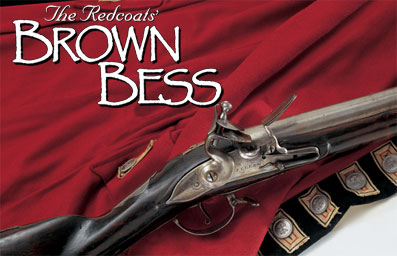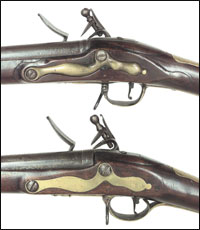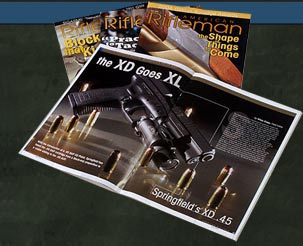
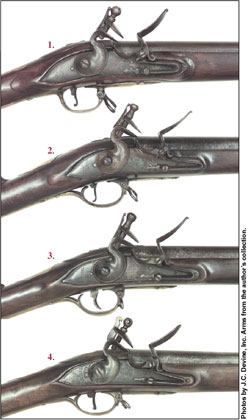 The original Brown Bess Lock (c. 1730) used a two-screw, rounded-surface, banana-shaped lock (No. 1) having a flat-backed swansneck cock, round flashpan without an exterior bridle, and a frizzen spring ending in a three-fingered finial plus a length covering the end of the forward lock screw. The next Long Land in 1742 (No. 2) added a bridle to the shallower flashpan and introduced a split in the trigger bow’s rear strut, while the raised stock carving was reduced. Engravings on the tail identify the maker and date, “farmer 1745.” This Long Land 1756 pattern (No. 3) replaced the curved banana lock with a straight form and further modified the wood carving. The lock design continued until 1777. Note its typical markings of a crown above “GR” (King George I-III) and a crown/broad arrow (indicating government ownership) under the flashpan. “TOWER” on the tail replaced the earlier maker’s name in 1764. In 1777, a less expensive lock (No. 4) was substituted in the Short Land pattern. Two screw ends are visible behind the cock, the frizzen spring has a lobe-shaped finial and terminates short of the forward lock screw’s end. Note, too, that the cock’s upper post is rectangular with a notch in its forward edge, while the upper jaw wraps around the post and has a lateral hole in the jaw screw. The shaded letters in “TOWER” on the tail indicate this example as probably one of the Liege contract muskets. |
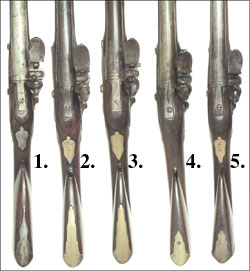 The walnut buttstocks of Brown Besses showed little change from 1730 through the 1790s. A circa 1715-1720 evolving pre-Bess pattern by Predden (No. 1) has iron furniture, a wavy butt tang, and undeveloped beavertail carving around the barrel tang. The 1730 and 1742 Long Lands (No. 2) introduced a 6" stepped brass butt tang and had a thick comb. By the time of the 1756 pattern (No. 3), the beavertail carving was established and the comb narrowed. The shortened barrel (42") Marine or Militia design (No. 4.) adopted a reduced 33⁄4" butt tang having a top screw and omitted an escutcheon. In 1768, the new Short Land standard infantry pattern (No. 5) kept both the reduced butt tang (without a top screw) and the escutcheon whose British marking, “B/14”, signifies Unit B, musket No. 14. |
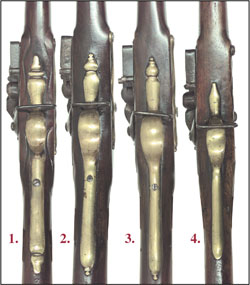 Brown Bess Trigger Guards include the first type (1.) as used on the Long Land Pattern 1730 guns, which still retained the early Dutch influence with lobed finials at each end. The next form (1742) standardized the hazelnut forward end design (2.). The following Long Land 1756 pattern (3.) thinned the shape to its final dimensions, which would continue through the Short Land series. (Note the visible rear screw passed through the stock’s wrist to secure the escutcheon.) Finally, a simplistic form was used on many of the private English commercial muskets (4.) to economize in brass and inletting costs. |
|
Brown Bess muskets were issued to “Redcoats” for nearly a century and served on both sides during the American Revolution. It began with a
contract by Britain’s Royal Board of Ordnance dated September 15,
1714. The document’s purpose was not to authorize additional arms,
but to develop a system of manufacture and control. The board would
accumulate components of a new standard longarm pattern and
inventory them at the Tower of London armory for release to private
contractors in time of need. They, in turn, would provide the
stocking and finishing of the final arms in conformity with a
prototype musket (usually bearing an official wax seal). Locks,
barrels and other iron components were to originate largely from
Birmingham, while most brass furniture, stocking and assembly would
be centered in London. All of the parts would then be subjected to
close quality and tolerance inspections by the Board of
Ordnance.
The majority of locally
manufactured rebel arms followed the English pinned barrel format
prior to the heavy import of French and other European military aid
beginning in 1777, which supplied most of the Continental Line for
the remainder of the war. Yet the Brown Bess remained a major share
of the arms carried by provincial forces through 1783—both as
complete muskets and as surviving components remounted on the large
number of locally assembled American arms. |
|
Evolution of the British Brown Bess Muskets 1715-1783 | ||||||
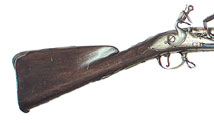 |
 | |||||
| The emerging Long Land Pattern is evident in this interim period private contract British musket made for the regiment of the Earle of Dunmore whose name appears on the barrel. (Most regiments were identified by their colonels’ names until given number designations in 1751.) The London maker, “W PREDDEN,” is engraved in the lock face, and his “WP” stamp appears on the breech above two private London Gunmakers’ Co. proofs. Its furniture is still iron, but the high-comb walnut stock and 46", .75-cal. barrel are already present, as well as the rounded two-screw banana lock, sling swivels, a top bayonet stud, the shield escutcheon, stock carving, plus a wooden ramrod. The wavy butt tang, four ribbed rammer pipes, and double-pointed trigger guard continue in their earlier forms. | ||||||
| Length: 62"
Barrel: 45 3/4", .77 cal. |
Lock: 6 1/4"x1 3/8" Trigger Guard: 11 1/2" |
Butt Tang: 5 3/4" Side Plate: 6 1/2" |
Furniture: Iron Weight: 9.3 lbs | |||
|
| ||||||
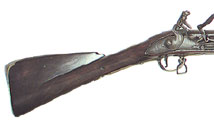 |
 | |||||
| This first of the Brown Bess muskets included the 46", .75-cal. barrel with a top bayonet stud, as well as a walnut stock that established the form for the entire series—a round wrist, handrail butt, raised carving around the lock and sideplate, plus a bulging hand hold just below the tailpipe. A rounded two-screw banana lock lacked an external bridle and had a wide flat upper post. Its furniture, now in brass, introduced a 6" long stepped butt tang, convex side plate with a tail, a shield escutcheon, plus a Dutch-style, lobed trigger guard. The wooden ramrod mounted a 1 1/2" brass tip and was held by four barrel-shaped pipes. Originally issued without a nose cap, some regiments added a brass strip around the end, as in this example. The large sling swivels had inside measurements of 2" wide for the upper one and 1 3/4" for the lower. | ||||||
| Length: 62 1/2"
Barrel: 46", .76 cal. |
Lock: 6 3/4"x1 1/8" Trigger Guard: 11 1/4" |
Butt Tang: 6" Side Plate: 6 1/4" |
Furniture: Brass Weight: 9.0 lbs. | |||
|
| ||||||
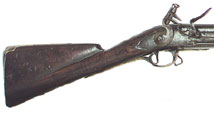 |
 | |||||
| Several alterations were incorporated at this time although the basic pattern continued intact. A new brass trigger guard introduced a split in the trigger bow’s rear strut and added a hazelnut shaped forward tip. The stock’s border carving and hand hold were reduced while the raised beavertail form surrounding the barrel tank was established and would continue as such into the 19th century. Its banana lock added an exterior bridle that joined its now shallower flashpan to the frizzen screw. The tail, in turn, is engraved with the name of the maker and the date of manufacture, “FARMER 1745.” Its fore-end continued to support the wooden ramrod in four brass, barrel-shaped pipes and had no end cap. | ||||||
| Length: 61 3/4"
Barrel: 45 3/4", .77 cal. |
Lock: 6 7/8"x1 1/4" Trigger Guard: 11 1/4" |
Butt Tang: 6" Side Plate: 6 1/4" |
Furniture: Brass Weight: 8.6 lbs. | |||
|
| ||||||
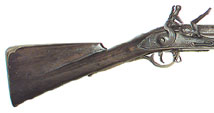 |
 | |||||
| Further upgrades appeared in this third and last of the official Long Land patterns with their 46" barrels. Conversion of existing muskets from wooden to steel button-headed ramrods began in 1748 and became a standard component of this new issue. Accompanying that change was the substitution of a longer 4" upper pipe having a flared mouth while all rammer pipe diameters were reduced for the thinner metal rod. The curved banana lock, in turn, was now straight and mounted a shorter frizzen spring, which no longer covered the end of the forward lock screw. Its stock and all carving were also thinner, and a new cast brass fore-end cap was finally adopted as standard. This design was the principal arm for most British regiments during the early years of the War for Independence. | ||||||
| Length: 61 7/8"
Barrel: 46", .78 cal. |
Lock: 7"x1 1/4" Trigger. Guard: 11 1/4" |
Butt Tang: 5 3/4" Side Plate: 6 1/8" |
Furniture: Brass Weight: 10.5 lbs. | |||
|
| ||||||
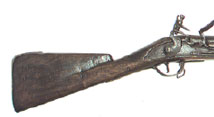 |
 | |||||
| While the official Brown Bess muskets were being issued through the Board of Ordnance to Royal forces, a parallel business existed for similar patterns being produced and sold by private British contractors to individual regimental colonels, trading companies, local English defense units and to provincial colonies, towns and militias in North America. They normally included a reliable lock and barrel, but would reduce or simplify the furniture and other components to remain competitive in price. This example has a full-length .75-cal. barrel and a typical banana lock marked by its London maker, “J Hall.” Yet it reduced cost by providing a low-grade walnut stock and wooden ramrod, plus an abbreviated butt tang, side plate and trigger guard. The tail pipe, escutcheon and nose cap, in turn, have been omitted. Even the usual British cast ramrod pipes were changed to rolled sheet brass. | ||||||
| Length: 61 3/8"
Barrel: 45 1/4", .78 cal. |
Lock: 7"x1 1/4" Trigger Guard: 8 7/8" |
Butt Tang: 2 1/2" Side Plate: 4" |
Furniture: Brass Weight: 9.1 lbs. | |||
|
| ||||||
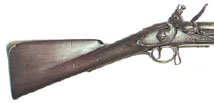 |
 | |||||
| During the French and Indian War, a new lower cost musket was approved for the British Marines and defense militias. It continued the basic Brown Bess configuration, but introduced a number of changes. The .75-cal. barrel was reduced from 46" to 42", and the side plate retained the Long Land outline yet was flat instead of convex. Its butt tang was shortened from 6" to 3 3/4" and employed a top screw (all other Besses used a side pin). The ramrod was wood, and the nose cap, bottom ramrod pipe and escutcheon were eliminated. In 1759, the design was upgraded (above) by adding a steel button-head ramrod, a long, flared upper pipe, a tailpipe and nose cap. The rounded lock continued to follow the straight pattern of the 1756 Long Land. Its tail is engraved by the maker, “Grice 1761.” This design continued in use by the British Marines through the American Revolution. (Bailey, Ref. 1, 2) | ||||||
| Length: 57 3/8"
Barrel: 41 1/2", .79 cal. |
Lock: 7"x1 1/4" Trigger Guard: 11 1/4" |
Butt Tang: 3 3/4" Side Plate: 6 3/8" |
Furniture: Brass Weight: 10.0 lbs. | |||
|
| ||||||
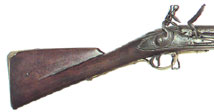 |
 | |||||
| Impressed by its experience with the Marine or Militia design, the Board of Ordnance approved a similar pattern during 1768 for issue beginning in 1769 as the new standard infantry arm. It adopted the shorter 42" (.75-cal.) barrel length as well as the flat side plate and reduced butt tang (no top screw), yet kept the straight double-bridled lock, steel ramrod, cast nose cap, escutcheon, four rammer pipes and hazelnut trigger guard of the 1756 Long Land (above). Limited production of Long Land muskets would continue for specific units until 1790. This new Short Land arm was issued gradually as earlier inventories were depleted. The regulation bayonet (4" socket; 17" blade) continued. The example shown is marked on the barrel, “71 Regt 1T B,” for Fraser’s 71st (Highland) Regiment of Foot (1775-1783). | ||||||
| Length: 58"
Barrel: 42", .77 cal. |
Lock: 7"x1 1/4" Trigger guard: 11 1/4" |
Butt Tang: 3 3/4" Side Plate: 6 1/4" |
Furniture: Brass Weight: 10.2 lbs. | |||
|
| ||||||
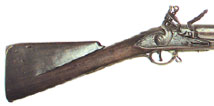 |
 | |||||
| As wartime pressures developed, two basic changes were approved for the Short Land musket in 1777. The second ramrod pipe was changed from the previous barrel shape to a straight sloping profile that created a larger forward opening that speeded the return of its ramrod. This was called “Pratt’s Improvement” and was already in limited use. The lock was also replaced by a less expensive design then being installed by contractors in muskets for the East India Co. Army. The remaining features duplicated the prior 1768 Pattern. Being approved during the third year of an eight-year war, this last of the Brown Bess series considered here still participated actively in the American Revolution. | ||||||
| Length: 57 3/4"
Barrel: 42", .78 cal. |
Lock: 6 7/8"x1 1/4" Trigger guard: 11 1/4" |
Butt Tang: 3 3/4” Side Plate: 6 1/4" |
Furniture: Brass Weight: 10.0 lbs. | |||
